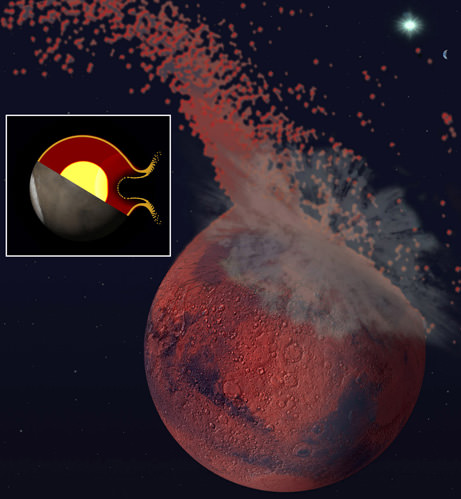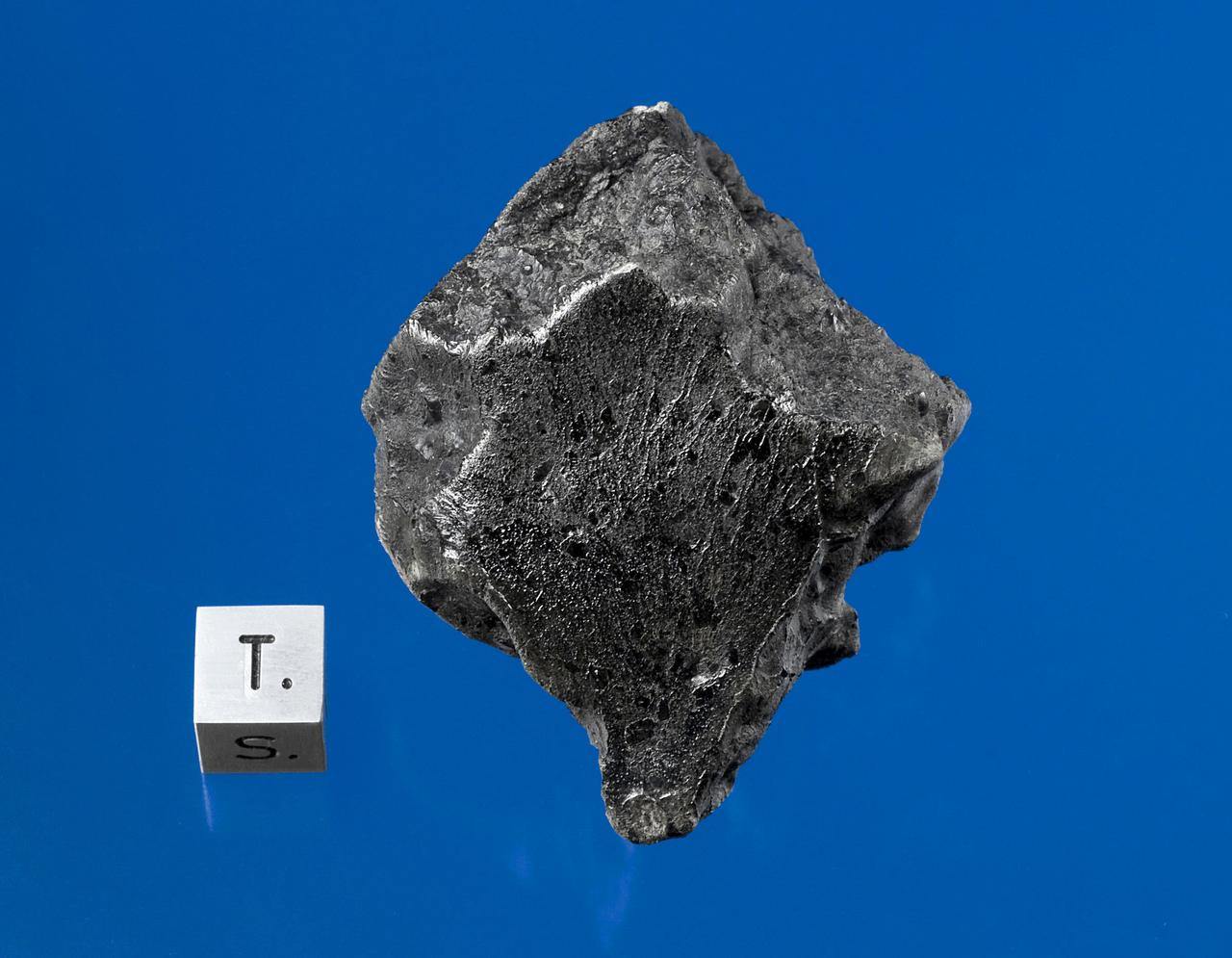[/caption]
Scientists studying life on Mars got a late Christmas present this year: confirmation that meteorites found in Morocco in December are of Martian origin. It’s a significant discovery; Martian meteorites fall to Earth only about once every 50 years making this a once-in-a-lifetime, and for many a once-in-a-career, event. The Mars rocks are worth more than their weight in gold, but what they can tell us could be even more valuable.
Astronomers suspect that the meteorite has been wandering around the solar system for millions of years, ever since something big smashed into the red planet and sent debris flying all directions. One of those pieces has wandered its way towards Earth and plunged through the atmosphere.

This is only the fifth time scientists have chemically confirmed the Martian origin of meteorites. Rocks found in France in 1815, in India in 1865, in Egypt in 1911, and in Nigeria in 1962 have all been positively identified as being from Mars.
The chemical signature of the Moroccan rocks and the Martian air match said Tony Irving of the University of Washington who did the scientific analysis. But this discovery is different. The rocks weren’t just found, they were seen streaking through the sky in July 2011, which makes them extremely valuable.
These rocks have only had six months to accumulate Earth-based materials and traces of life; typically Martian meteorites found on Earth have been here anywhere from decades to millennia, giving them ample time to become tainted.
These new rocks, while still contaminated because they have been on Earth for months, are relatively pure. “It’s incredibly fresh. It’s highly valuable for that reason,” said Carl Agee, director of the Institute of Meteoritics and curator at the University of New Mexico.
It’s also a rare find. This new sample, about 15 pounds of rocks, brings the total weight of all Martian samples on Earth to just 240 pounds.
Meteorite dealer Darryl Pitt is cashing in on the rocks’ rarity and selling pieces for $11,000 to $22,500 an ounce and has sold most of his supply already. At that price, the Martian meteorite costs about 10 times as much as gold.

Cornell University astronomer Steve Squyres, the principal investigator for NASA’s Mars Exploration Rover Program, is less excited. The rocks, he said, are not the kind scientists are most hoping for. They are hard, igneous or volcanic rock. A softer kind of rock capable of holding water or life would be better. But he also points that these rocks aren’t likely to come streaking through the atmosphere. Any soft rock would be unlikely to survive the fiery entry through Earth’s atmosphere.
Former NASA sciences chief Alan Stern, director of the Florida Space Institute at the University of Central Florida, takes a brighter outlook. “It’s nice to have Mars sending samples to Earth,” he said, “particularly when our pockets are too empty to go get them ourselves.”
Until we manage a sample return mission from Mars, this is the best shot scientists have to study the red planet up close.
Source: physorg.


“This is only the fifth time scientists have chemically confirmed the Martian origin of meteorites. Previous rocks from Mars were positively identified in France in 1815, in India in 1865, in Egypt in 1911, and in Nigeria in 1962.” My first comment was “how the dickens did anyone working in 1815 chemically identify something as Martian?!” As well, http://en.wikipedia.org/wiki/Martian_meteorites says that 99 Martian meteorites have been positively identified, not jsut 5.
May I suggest that it be rewritten along these lines? “This is only the fifth time scientists have used chemical methods to confirm the Martian origin of meteorites. The other ones were meteorites that fell in France in 1815, in India in 1865, in Egypt in 1911, and in Nigeria in 1962.”
Thanks for this! I was unable to hunt down the initial press release at the time, and I wondered about the nature of those rocks.
Tissint is a shergottite, the most common martian meteorite.
On the other hand, I was able to run down the origin of the impactor image, for those who are interested in the “three new studies” of the large Mars impactor. (They are from 2008, so actually a bit dated as science.) Usually it is referred to as Moon sized, which suggests a mnemonic – Earth was hit by a Mars sized object, creating the Moon; Mars was hit by a Moon sized object.
Since Vesta is added to the list of bodies with late large impactors, let’s redo the list (using diameters):
Mercury ~ 5 000 km: Caloris Basin ~ 1 500 km, suggesting a ~ 100 km impactor.
Venus (~ 12 000 km): the reverse rotation (has other explanations too), suggesting ~ 3 000 km impactor.
Earth ~ 12 500 km: Moon forming impactor ~ 3 000 km.
Moon ~ 3 500 km: South Pole-Aitken basin ~ 2 500 km, suggesting ~ 100 km impactor.
Mars ~ 7 000 km: Borealis, ~ 3 000 km impactor.
Vesta ~ 500 km: Rheasilvia ~ 500 km from two overlapping impacts, suggesting 2x ~ 20 km inpactors.
Mimas ~ 400 km: Herschel ~ 100 km, suggesting ~ 5 km impactor.
Pluto ~ 3000 km: Charon binding (less likely its creation), ~ 1 000 km impactor.
That gives the following impacted/impactor linear ratios:
~ 50, ~ 4, ~ 4, ~ 40, ~ 2, ~ 20, ~ 100, ~ 3.
Seems the median is ~ 4. That is some big bullets, as expected they would be about as large as the other planet/asteroid they hit.
[Should be cubic ratios to compare masses, in which case the impactor median is ~ 1/20 of the impacted instead. Then a mere order of magnitude from “about as large”.]
How would a rock detach itself from Mars and land here?
The tip off is in the article:
“Astronomers suspect that the meteorite has been wandering around the solar system for millions of years, ever since something big smashed into the red planet and sent debris flying all directions. One of those pieces has wandered its way towards Earth and plunged through the atmosphere.” Illustrated in the last figure.
A more thorough sketch of the physics is that Mars (and Moon) meteorites gets to Earth by way of massive hypervelocity impactors.
When an asteroid meets a planet is happens with a differential velocity on the order of typical planet orbital speeds, ~ 20-30 km/s. This means the resulting shock wave speed of impacted rocks travel much faster than the natural speed of sound of ~ 2-3 km/s (in solids) aka hypervelocity, and as a result there is a massive crater and ejecta blanket much more massive than the original impactor. (See the last figure.)
Some of that ejecta makes the impacted body’s escape velocity.
For example, Earth escape velocity is ~ 10 km/s, and then a ~ 20 km/s impactor makes some escaping ejecta. IIRC typically ~ 1-5 % of the ejecta escapes into space according to models. (Happened latest at the K-Pg Chixculub impactor, the ‘dinosaur killer’.)
The launched ejecta can take a trajectory that eventually hits Earth sometimes. As Tim McDaniel notes we have found a relatively modest amount of Mars rocks compared to other meteorites. The launching impacts happens relatively frequently though, see the number of Mars, and Moon, craters. Earth is hit too but plate tectonics and weathering erodes the traces over time so we erroneously feels it is more infrequent than it is.
What about ALH 84001, from Antarctica? That was the most famous one of all.
The whole impactor thing reminds me of Stephen Baxter and Arthur C Clarke’s Firstborn – in that book that Mars impactor really was due to alien intervention!
This is amazing! I couldn’t even imagine that finding rocks from Mars is possible before watching a video on the subject with my avi player, which was very impressive, and the atricle has really got me thinking about the value of the rocks… it’s unbelievable!